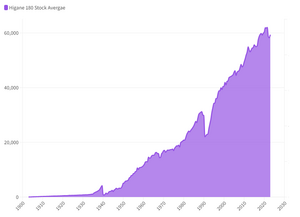Economy of Tayichi: Difference between revisions
No edit summary |
No edit summary |
||
| (11 intermediate revisions by the same user not shown) | |||
| Line 9: | Line 9: | ||
| year = 1 April - 31 March | | year = 1 April - 31 March | ||
| organs = AMA | | organs = AMA | ||
| gdp = $3. | | gdp = $3.253 Trillion | ||
| gdp rank = ?TBD | | gdp rank = ?TBD | ||
| growth = 2.1% (2010-21 avg.) | | growth = 2.1% (2010-21 avg.) | ||
| Line 15: | Line 15: | ||
1.3% (2025f) | 1.3% (2025f) | ||
1.5% (2026f) | 1.5% (2026f) | ||
| per capita = $48, | | per capita = $48,633 | ||
| per capita rank = ?TBD | | per capita rank = ?TBD | ||
| sectors = Agriculture: 0.7% | | sectors = Agriculture: 0.7% | ||
Industry: 26.1% | Industry: 26.1% | ||
Services: 73.2% | Services: 73.2% | ||
(2023) | (2023) | ||
| Line 36: | Line 38: | ||
| occupations = Agriculture: 1.3% | | occupations = Agriculture: 1.3% | ||
Industry: 22.5% | Industry: 22.5% | ||
Services: 76. | Services: 76.2% | ||
| unemployment = 5.0% (2023) | | unemployment = 5.0% (2023) | ||
| average gross salary = $4,125 | | average gross salary = $4,125 | ||
| gross median = | | gross median = | ||
| average net salary = $ | | average net salary = $3,034 | ||
| net median = | | net median = | ||
| industries = High technology, motor vehicles, electronics, machine tools, ships, defence, chemicals, biotechnology, pharmaceutical, consumer products | | industries = High technology, motor vehicles, electronics, machine tools, ships, defence, chemicals, biotechnology, pharmaceutical, consumer products | ||
| Line 54: | Line 56: | ||
Amnis: ?TBD | Amnis: ?TBD | ||
Others: ?TBD | Others: ?TBD | ||
| FDI = Inward: $1.682 trillion | | FDI = Inward: $1.682 trillion | ||
Outward: $1.566 trillion | Outward: $1.566 trillion | ||
| current account = -$88.5 billion | | current account = -$88.5 billion | ||
(-2.7% of GDP) | (-2.7% of GDP) | ||
| gross external debt = $5.342 trillion (2024) | | gross external debt = $5.342 trillion (2024) | ||
| debt = $ | | debt = $3.146 trillion (2024) 96.7% of GDP | ||
| balance = ?TBD% of GDP | | balance = ?TBD% of GDP | ||
| revenue = ?TBD% of GDP (2023) | | revenue = ?TBD% of GDP (2023) | ||
| expenses = ?TBD% of GDP (2023) | | expenses = ?TBD% of GDP (2023) | ||
| credit = Standard & Poor's: | | credit = Standard & Poor's: | ||
AA+ (Domestic) | AA+ (Domestic) | ||
AA+ (Foreign) | AA+ (Foreign) | ||
AAA (T&C Assessment) | AAA (T&C Assessment) | ||
Outlook: Stable | Outlook: Stable | ||
Moody's: | |||
Aa2 | Aa2 | ||
Outlook: Stable | Outlook: Stable | ||
Fitch: | |||
AA+ | AA+ | ||
Outlook: Stable | Outlook: Stable | ||
Scope: | |||
AA | AA | ||
Outlook: Stable | Outlook: Stable | ||
| reserves = $288 billion | | reserves = Government = $288 billion | ||
Imperial Bank = $36 billion | |||
| spelling = Oxford or US spells 'z', US '-or'; 's', '-our' spelling by default | | spelling = Oxford or US spells 'z', US '-or'; 's', '-our' spelling by default | ||
| usebelowbox = yes or no; default value is "yes"; shows/hides bottom box | | usebelowbox = yes or no; default value is "yes"; shows/hides bottom box | ||
| Line 87: | Line 105: | ||
In the 19th century Tayichi was the first [[Boralia|Borealian]] and non-Amnisian nation to industrialize. Tayichi emerged as one of the centers of the Second Industrial Revolution in the late 19th century, rapidly increasing Tayichi's economic power on the global scale - At the turn of the 20th century, Tayichi was the [ranking] largest economy in the world, many places ahead when compared to today, and remained the largest economy in Borealia in terms of nominal GDP until 1996. The cost of fighting the [[The Great War (1923-1939)|Great War]], however, greatly weakened Tayichi's relative position. Despite a relative decline in global importance, in the 21st century Tayichi retains the ability to project significant power and influence around the world. | In the 19th century Tayichi was the first [[Boralia|Borealian]] and non-Amnisian nation to industrialize. Tayichi emerged as one of the centers of the Second Industrial Revolution in the late 19th century, rapidly increasing Tayichi's economic power on the global scale - At the turn of the 20th century, Tayichi was the [ranking] largest economy in the world, many places ahead when compared to today, and remained the largest economy in Borealia in terms of nominal GDP until 1996. The cost of fighting the [[The Great War (1923-1939)|Great War]], however, greatly weakened Tayichi's relative position. Despite a relative decline in global importance, in the 21st century Tayichi retains the ability to project significant power and influence around the world. | ||
[[File:Nininini.png|left|thumb|Taikei 180 Index of the Shuto Imperial Exchange since 1903 ]] | |||
WP | |||
[[Category:Lands End]] | [[Category:Lands End]] | ||
Latest revision as of 18:14, 20 September 2024
This article is incomplete because it is pending further input from participants, or it is a work-in-progress by one author. Please comment on this article's talk page to share your input, comments and questions. Note: To contribute to this article, you may need to seek help from the author(s) of this page. |
 | |
| Currency | Tayichian Kin (TKN) |
|---|---|
| No | |
| 1 April - 31 March | |
Trade organisations | AMA |
| Statistics | |
| GDP | $3.253 Trillion |
| GDP rank | ?TBD |
GDP growth | 2.1% (2010-21 avg.)
1.6% (2024) 1.3% (2025f) 1.5% (2026f) |
GDP per capita | $48,633 |
GDP per capita rank | ?TBD |
GDP by sector | Agriculture: 0.7%
Industry: 26.1% Services: 73.2% (2023) |
GDP by component | Private consumption:
Government consumption: Gross capital formation: Exports of goods and services: Imports of goods and services: Net exports: (2023) |
| 0.9% (2024) | |
| 4.75% (May 2024) | |
Population below poverty line | 16.1% at risk of poverty or social exclusion |
| 35.4 (2023) | |
| 0.940 | |
Labour force | 32,652,797 |
Labour force by occupation | Agriculture: 1.3%
Industry: 22.5% Services: 76.2% |
| Unemployment | 5.0% (2023) |
Average gross salary | $4,125 |
| $3,034 | |
Main industries | High technology, motor vehicles, electronics, machine tools, ships, defence, chemicals, biotechnology, pharmaceutical, consumer products |
| ?TBD | |
| External | |
| Exports | $1.011 trillion |
Main export partners | Borealia ?TBD%
Amnis: ?TBD% Others: ?TBD% |
| Imports | $1.08 trillion |
Main import partners | Borealia ?TBD
Amnis: ?TBD Others: ?TBD |
FDI stock | Inward: $1.682 trillion
|
| -$88.5 billion (-2.7% of GDP) | |
Gross external debt | $5.342 trillion (2024) |
| Public finances | |
| $3.146 trillion (2024) 96.7% of GDP | |
| ?TBD% of GDP | |
| Revenues | ?TBD% of GDP (2023) |
| Expenses | ?TBD% of GDP (2023) |
| Standard & Poor's:
AA+ (Domestic) AA+ (Foreign) AAA (T&C Assessment) Outlook: Stable Moody's: Aa2 Outlook: Stable Fitch: AA+ Outlook: Stable Scope: AA Outlook: Stable | |
Foreign reserves | Government = $288 billion Imperial Bank = $36 billion |
All values, unless otherwise stated, are in US dollars. | |
The economy of Tayichi is a highly developed social market economy. It is the [ranking] largest national economy in the world measured by nominal gross domestic product (GDP), [ranking] by purchasing power parity (PPP) and [ranking] by nominal GDP per capita. Tayichi constitutes of ?TBD% of world GDP.
The service sectors dominates the Tayichian economy, contributing over 73% of GDP, with financial services industry of particular importance due to Shuto's position as the [ranking] largest financial center in the world. Its technology sector is one of the most highly valued, surpassing $900 billion last year. There are significant regional variations in prosperity, with the Taīga-Kaidō Plain accounting for almost 60% of the entire national GDP, while some northern provinces like Teikai, Miyagi and Kitajima have per capita values much lower than the national average.
In the 19th century Tayichi was the first Borealian and non-Amnisian nation to industrialize. Tayichi emerged as one of the centers of the Second Industrial Revolution in the late 19th century, rapidly increasing Tayichi's economic power on the global scale - At the turn of the 20th century, Tayichi was the [ranking] largest economy in the world, many places ahead when compared to today, and remained the largest economy in Borealia in terms of nominal GDP until 1996. The cost of fighting the Great War, however, greatly weakened Tayichi's relative position. Despite a relative decline in global importance, in the 21st century Tayichi retains the ability to project significant power and influence around the world.
WP
